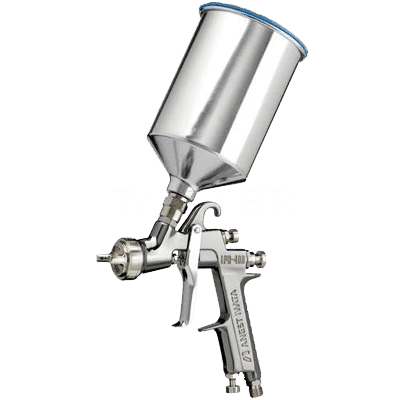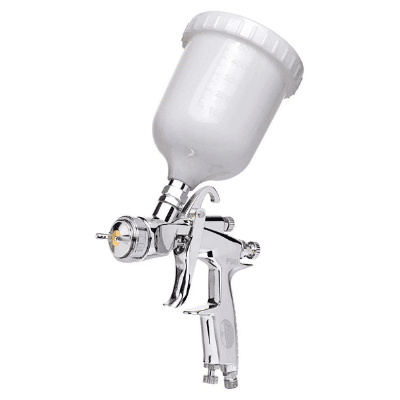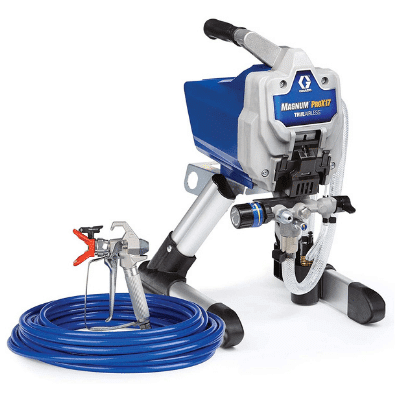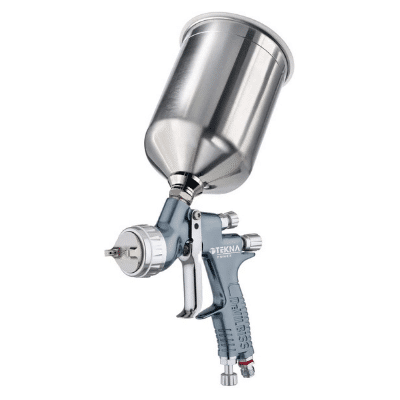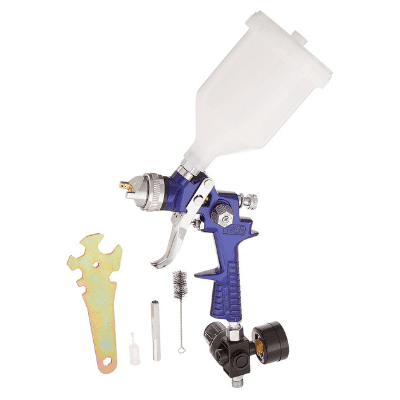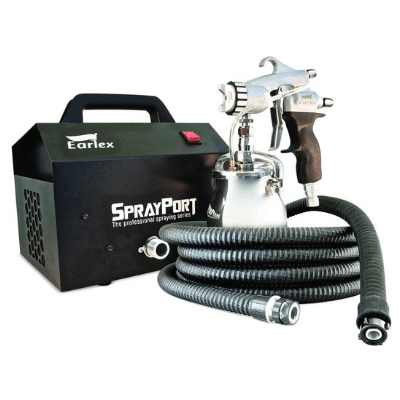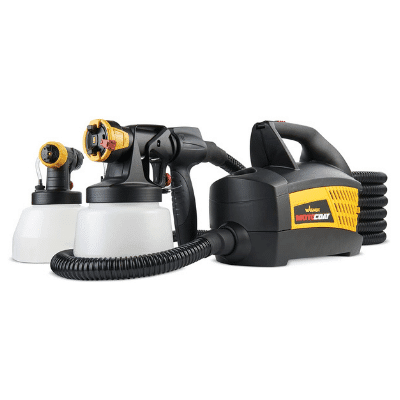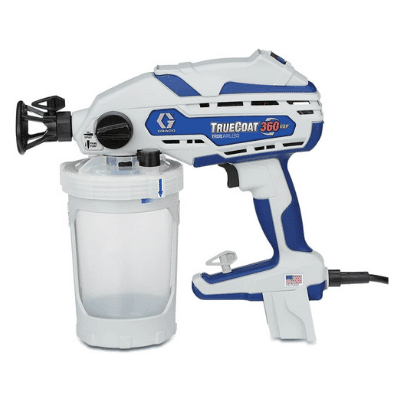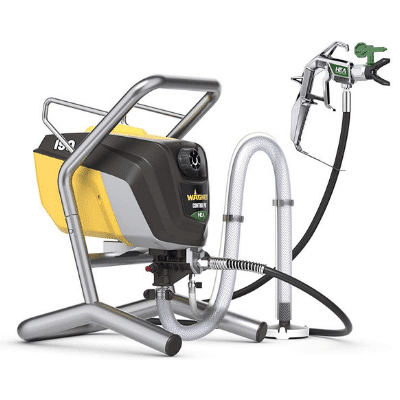Best Primer Spray Gun — Buyer’s Guide, How-To, Reviews, and Comparison
A superior primer spray gun will deliver enough power to make short work of any priming project. Whether airless, HVLP, or compressor-driven it should support a suitably-sized nozzle tip — that can stand up to this dense material —, offer task-tailorable settings, and be operator-friendly.
- 1.8 mm fluid tip.
- 0.74-quart paint container.
- Ideal for homeowners or professionals.
- Durable construction.
Primer Spray Gun Comparison Table
| IMAGE | PRODUCT | DETAILS | ||
|---|---|---|---|---|
|
Best Gravity-Feed Spray Gun
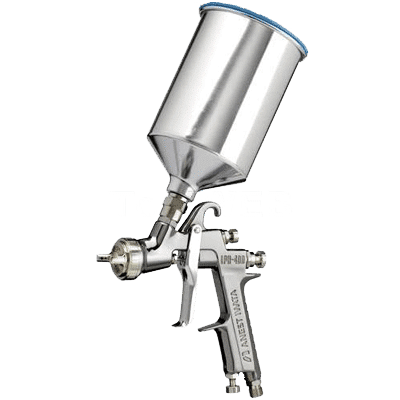
|
Best Gravity-Feed Spray Gun
|
Features
|
Check Price at Amazon Iwata LPH440-181 Review Iwata LPH440-181 Review | |
|
Best Lightweight
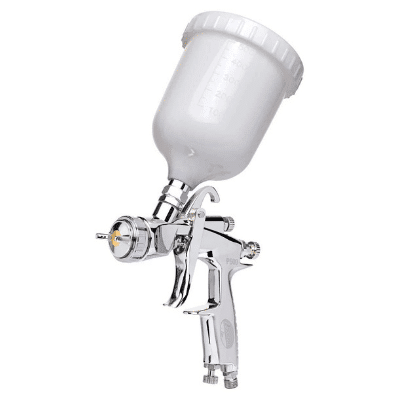
|
Best Lightweight
|
Features
|
Check Price at Amazon Eastwood Elite P500 Review Eastwood Elite P500 Review | |
|
Best for Large-Scale Projects
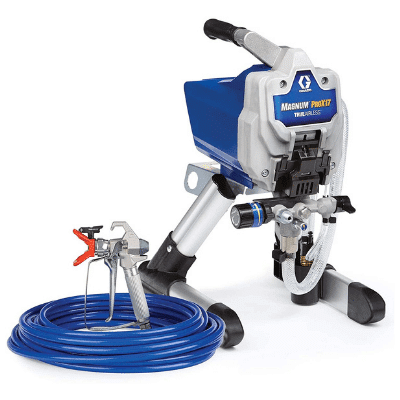
|
Best for Large-Scale Projects
|
Features
|
Check Price at Amazon Graco Magnum ProX17 Review Graco Magnum ProX17 Review | |
|
Best for Dual Technology
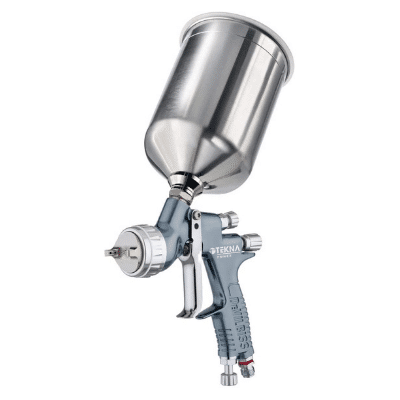
|
Best for Dual Technology
|
Features
|
Check Price at Amazon Tekna 704174 Review Tekna 704174 Review | |
|
Best HVLP Primer Spray Gun
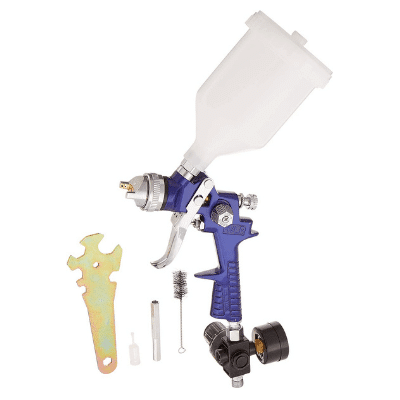
|
Best HVLP Primer Spray Gun
|
Features
|
Check Price at Amazon Vaper 19000 Spray Gun Review Vaper 19000 Spray Gun Review | |
|
Best Turbine Primer Spray Gun
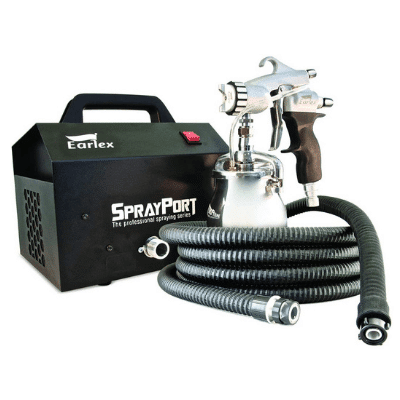
|
Best Turbine Primer Spray Gun
|
Features
|
Check Price at Amazon Earlex 0HV6003PUS Review Earlex 0HV6003PUS Review | |
|
Best for Automobiles
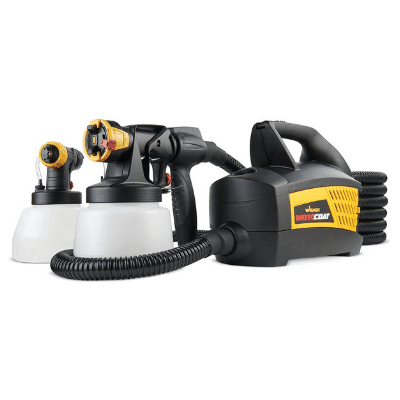
|
Best for Automobiles
|
Features
|
Check Price at Amazon Wagner MotoCoat Review Wagner MotoCoat Review | |
|
Best Handheld
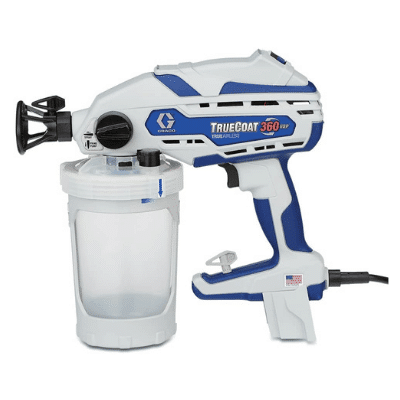
|
Best Handheld
|
Features
|
Check Price at Amazon Graco 17D889 Review Graco 17D889 Review | |
|
Best Airless Primer Spray Gun
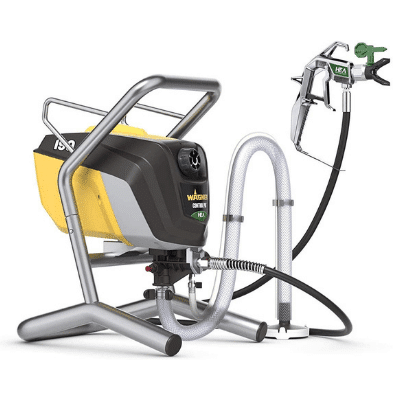
|
Best Airless Primer Spray Gun
|
Features
|
Check Price at Amazon Wagner Control Pro 190 Review Wagner Control Pro 190 Review |
Primer Spray Gun Buying Guide
These heavy-duty machines must include some essentials — such as:
- Perfectly-sized primer compatible nozzle.
- Adequate power.
- Be effortless to maneuver.
- Adjustable settings.
Why Use Primer Paint?
Hence, a primer spray gun is called upon to lay down this ‘blank canvas’ in readiness for further coating jobs. Primer should be used on almost every painting project — wood, previously painted dark surfaces, metal, and coated brickwork.
How To Choose the Best Primer Spray Gun
Follow me as I go step-by-step through each crucial component you should assess before parting with your hard-earned bucks.
Nozzle Size
Don’t forget, nozzle size also determines the diameter of your fan pattern — so you’ll need to take the size of your project into account too.
While many sprayers include the perfectly sized fluid tip upon purchase, if you find a device where all other features fit your needs, check to see whether other tip sizes are supported.
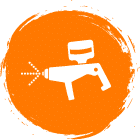
Pressure Output
As primer is a fairly dense coating, it requires a decent amount of pressure to drive it through the sprayer — and ultimately push out finely atomized paint particles. As a general rule, a minimum pressure output of 20 PSI on compressor-driven HVLP setups is recommended by most pros.
However, as all primers are individual products, they may differ slightly in viscosity. For the most up-to-date advice, check the individual coating manufacturer’s guidelines, or take a look at my Paint Sprayer Pressure Guide.
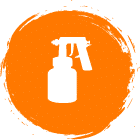
Portability
If you’re considering a handheld unit, this isn’t so much of an issue. Yet for larger machines — a lightweight unit, wheels, and built-in handles are features that maximize portability.

Adjustable Settings
The ability to dial up the volume or pressure output to complete a job rapidly is advantageous — you don’t want to go at a snail’s pace if you’re an experienced sprayer, and vice versa. Plus, when completing smaller-sized projects, being able to tone down the output is paramount.

Ease of Use
Look for user-friendly functions for both pre, during, and post-task. A great example of this is the PushPrime feature found on many Graco devices — at one push of a button, priming commences.
Compressor vs Inbuilt Motor
However, a unit with an inbuilt turbine can sometimes keep costs down — as you don’t need to invest in a separate external compressor. That said, if you already own a compressor for other power tools, then perhaps it would be money better spent on a plethora of spray guns.
How To Use a Primer Spray Gun
Using a primer spray gun may seem like a formidable task, but with a little determination, preparation, and my handy how-to guide, you’ll be spraying like a pro in no time at all.
As there are so many different surfaces you can prime, I decided to focus on straightforward kitchen cabinets. However, the technique is pretty much similar for most other base mediums.
What You Will Need to Follow This Tutorial
Before you start, make sure that you have everything to hand to ensure that you achieve the best results.
- Primer spray gun.
- Primer.
- Floorcloths.
- Screwdriver.
- Stir stick.
- Sandpaper.
- Cleaning cloths.
- Water.
- Masking tape.
- Coveralls or old clothes.
- Personal protective gear — mask, respirator, goggles, sprayhood.
How To Spray Kitchen Cabinets with Primer: A Step by Step Guide
Step 1: Preparing Your Furniture and Workspace
- Start by choosing a spacious, well-ventilated area and lay down your floorcloths.
- Place your cabinets in the center and set about removing all the doors and handles that may be present. It’s a great idea here to attach hardware and screws together with masking tape and label them.
- Sand all the surfaces of the cabinet frame, doors, and any drawer faces. Remember — go with the grain when sanding, as this will reduce any scratches.
- Once you have completed the sanding, wipe the surfaces down with a damp cloth to remove all the dust. Then allow it to dry completely.
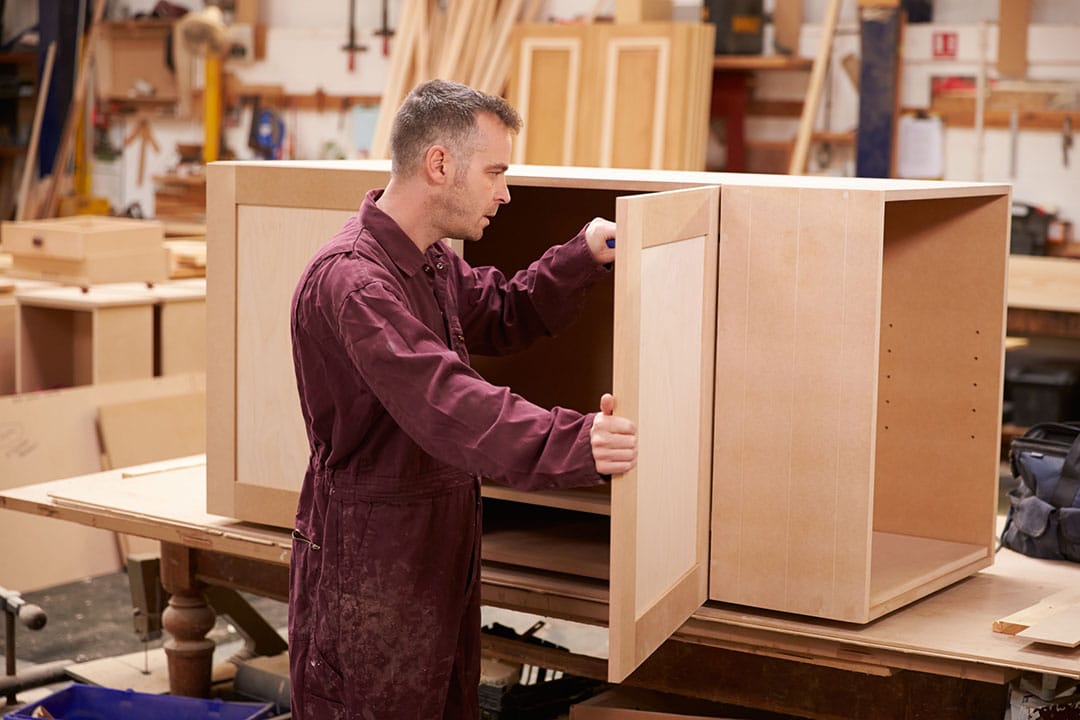
Step 2: Start Priming
- Put on all of your safety gear and set your sprayer up — following the manufacturer’s guidelines.
- Start spraying! Maintain a distance of 12 inches from the cabinet surface for optimum results. Another handy hint for the best results is to spray in the same direction of the wood grain if possible.
- Pass each previous spray stroke by at least fifty percent to ensure even coverage.
- Typically, most primer manufacturers recommend two coats. So, follow the instructions as to how much time to leave between coats before you progress to the second application.
- Once you’ve finished applying the second coat, allow it to dry completely before moving on to your topcoat.
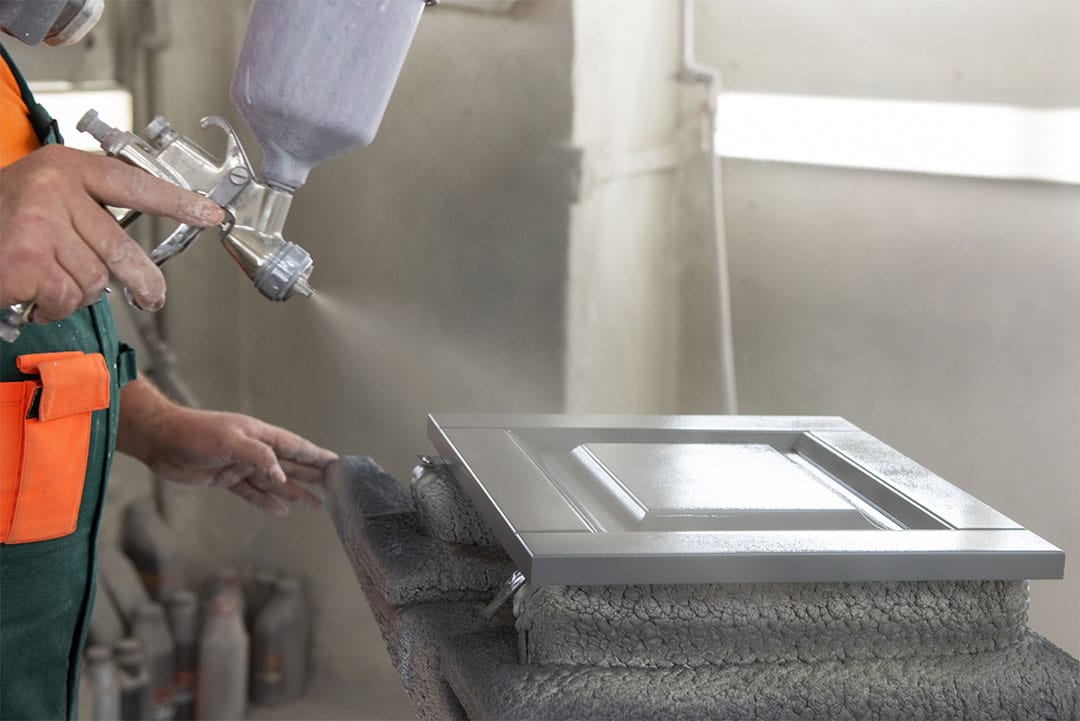
Step 3: Finishing Up
- Once you’ve finished with the second coat of primer, try to clean your sprayer as soon as possible. If you let residual paint dry in the unit, it will be harder to clean in the long run and could cause long-term damage.
- Once your final finishing coat has dried, reattach all the hardware, doors, and handles.
- Tidy away any floor cloths.
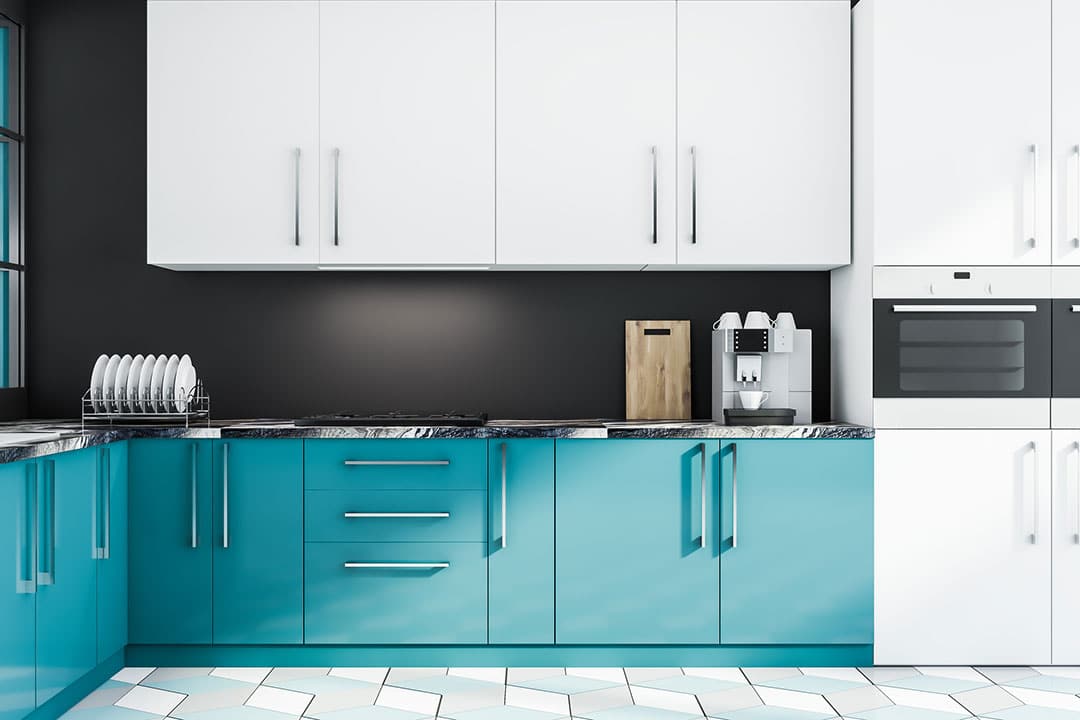
Nine of the Best Primer Spray Guns
So, tell your wife, you’ll soon have that project — she’s been on about for what seems like an eternity — finished. Gently remind her it’s all in the preparation, grab a coffee and take a read.
While you will require a compressor to operate this spray gun, as it incorporates HVLP technology, the result is a fine, even coat on your project. What’s more, the fan pattern, fluid delivery, and air pressure output are completely adjustable — providing you with full tailorability.
Its 1.8 mm tip is the perfect size for primer. However, other size nozzles are available — 1.4, 1.6, 2.0, and 2.5 mm — which permits use with sealers and polysurfacers.
The 0.7-quart (700 ml) paint cup holds sufficient medium for most mid-size tasks. And, weighing in at 2.3 pounds, this durable spray gun is relatively lightweight — ideal for maneuverability.
Anest Iwata is a North-American branch of the Japan-based Anest Iwata Corporation. It’s a leading manufacturer that specializes in vacuum pumps, air compressors, and paint equipment.
- Delivers fine atomization.
- 1.8 mm fluid nozzle.
- 0.74-quart gravity-feed paint cup.
- Suitable for DIYers and contractors.
- Durable yet lightweight.
- Other cup and nozzle sizes available.
- Requires an external compressor.
- Design
- Functionality
- Price
The fluid control dial includes four stages — allowing you to vary the volume of coating laid down. It also features controllable airflow, so that you can adapt your output to match your medium.
A 0.63-quart (600 ml) paint container and two different sized fluid tips are included (1.7 and 2.0 mm), which make handling viscous primers no big deal. Plus, you only require a small compressor with the capability to operate at 9.5 CFM at 30-40 PSI.
Additionally, the outer and inside components are constructed from stainless steel — which substantially increases the longevity of this machine. Furthermore, this gun arrives with everything you need to get started right away — air pressure regulator, wrench, and cleaning brush.
Eastwood has been manufacturing DIY tools angled toward automotive use since 1978. It prides itself on keeping in touch with the community by attending car shows and finding out exactly what its customers need.
- 1.7 and 2.0 mm spray nozzles.
- Compressor requirements 9.5 CFM at 40 PSI.
- Includes wrench, air regulator, and cleaning brush.
- Durable stainless steel construction.
- 0.63-quart coating cup.
- Variable volume and pattern size.
- Tricky to clean.
- Design
- Functionality
- Price
Adjustable pressure output provides control throughout your project. While the DC motor drives enough grunt to make short work of immense jobs — with a recommended usage of an impressive 300 gallons per year.
comes with a RAC 515 fluid nozzle, but this can be switched up to a maximum of 0.017-inch orifice (at an additional purchase).
The pump can be replaced out in the field effortlessly, thanks to the ProXchange system — with no tools required. A clever PushPrime button provides fast priming, and end-of-day cleaning is sped up dramatically with the Power Flush — simply connect to your garden hose to give the unit a thorough rinse.
Graco is one of the powerhouses of the spray painting industry and manufactures quality reliable products for dedicated home improvers, as well as everyday tools for pros. Sixty years after its formation, Graco invented the first portable airless spray gun.
- Ideal for large-scale projects.
- Easily transported.
- 0.34 GPM maximum flow rate.
- Adjustable pressure.
- Many time-saving features.
- TrueAirless RAC 515 nozzle.
- Flexible uptake tube.
- Not suited to smaller projects.
- Design
- Functionality
- Price
Since there are two fluid nozzles included (1.4 and 1.6 mm), operating with heavy viscous primers is effortless. There is also a large 0.95-quart paint cup that minimizes interruptions caused by constant refilling.
As mentioned, HE and HVLP technology are incorporated in the air caps. The PR10 cap delivers a rectangular pattern of between 10.5 and 12 inches, while the PR30 lays an elliptical shape between 11 and 13 inches.
While this sprayer stands up to the abuse of daily use, which is great for professionals but it is also simple enough for even the most inexperienced decorator to use. The package also includes a handy gun wrench — minimizing the need to purchase extra specialized tools.
DeVilbiss is one of the preferred suppliers of spray guns for gearheads — with most of its products aimed toward the automobile market. However, its sprayers can be used for other applications if needed.
- PR10 (1.4 mm) and PR30 (1.6 mm) air caps.
- Polyester 0.95-quart coating cup.
- Includes wrench.
- Large spray patterns.
- Lighter trigger pull due to balanced air valve.
- Overkill for smaller priming tasks.
- Design
- Functionality
- Price
Manufactured from long-lasting die-cast aluminum, this unit includes a lockable air regulator and gauge — meaning all you have to supply is a compressor. Accompanying the gun is a 0.63-quart paint container complete with a screwable cap, plus a strainer — making refills a mess-free affair.
A two-speed trigger control combined with a fan pattern control dial and an adjustable width of spray provides you with results — with minimum effort. While the 1.4 mm stainless steel tip and needle are well suited to operating with viscous primers up to a pressure of 100 PSI.
This kit also includes a cleaning brush and wrench to make set-up and maintenance straightforward.
Vaper from Titan is a subsidiary of the Star Asia USA group and formed almost two decades ago. This company strives to create innovative, practical products for painters of every level — from occasional DIYers to hardcore pros.
- Gravity-fed no-bleed HVLP spray gun.
- Includes inline air regulator and gauge.
- 1.4 mm stainless steel needle and nozzle.
- 0.63-quart plastic paint cup.
- Variable medium output, fan pattern, and air intake.
- Requires an external compressor.
- Design
- Functionality
- Price
Due to the three-stage turbine, an output of 5.5 PSI and 90 CFM is possible — providing fine atomization even when operating with highly viscous mediums. Furthermore, HVLP technology assures minimum overspray.
The non-bleed Pro 8 spray gun includes a stay-cool handle for extra spraying comfort and is fitted with a 1.3 mm needle and cap (additional sizes of between 0.8 to 2.5 mm are available and can be purchased separately). Additionally, the air cap is rotatable through 360 degrees, facilitating spraying at any angle.
A quick-connect flexible 25-foot hose permits substantial reach on medium-scale projects. While the one-quart paint cup will keep coating refills to a minimum.
Earlex is owned by the global giant Wagner SprayTech. In this merging of minds, together they strive to produce innovative, durable machines angled towards experienced professionals and occasional DIYers.
- HVLP non-bleed spray gun.
- Three-stage turbine delivers 5 PSI.
- 0.12 gallons per minute.
- 1.3 mm air cap and nozzle.
- 25-foot flexible hose.
- Unsuitable for extremely large jobs.
- Design
- Functionality
- Price
Volume delivery is adjustable, which enables you to precisely control how much paint ends up on your surface. Power control can also be adapted to your spraying pace. This provides you with the ability to tailor the output to your chosen coating and project size.
It’s a completely self-contained device fitted with a 39-foot hose — allowing you to maneuver easily around your task. Furthermore, the material volume and fan pattern width and direction are straightforward to adjust — guaranteeing flawless results.
Wagner SprayTech aspires to create innovative purposeful machines for any paint application. In recent years it has also bought out several of its competitors in the spray painting world — making them a force to be reckoned with.
- Straightforward to use.
- X-Boost floor-based turbine.
- Two different nozzles and paint cups.
- Flexible 39-foot hose.
- Variable coating output.
- May not be ‘man’ enough for professional use.
- Design
- Functionality
- Price
Handheld primer spray guns such as the airless Graco 17D889 TrueCoat 360 VSP will not only assist you with speedy coverage — but also with optimal portability. Furthermore, the VacuValve technology creates the ability to spray at multiple angles, making coating those hard-to-reach areas a breeze.
This easy-to-use device includes variable speed control — allowing you to spray at your own pace. It’s also extremely lightweight, coming in at under four pounds — minimizing bothersome arm fatigue.
Traditional style container cups are replaced by the FlexLiner bag system with a capacity of 42-ounces (1.31-quart) — that can easily be switched out when you want to change color or medium.
To finish off this package, a storage case and step-by-step user manual are included — and the whole sprayer is proudly made in the USA.
Graco’s Truecoat line-up is part of the Project Series, a collection of airless sprayers designed for midsized tasks — used by home-improvers and contractors requiring a compact unit. Graco is well known in the industry for its reliable tools and impressive customer service.
- VacuValve system provides multi-angle spraying.
- Four 42-ounce paint bags.
- Adjustable pressure output between 500 and 1500 PSI.
- Two reversible 0.015-inch fluid tips.
- Storage case and user manual included.
- Longer power cord could be an improvement.
- Design
- Functionality
- Price
This versatile machine is straightforward to set up and use, and its flexible suction tube eliminates messy paint cup refilling. While the HEA pump delivers a maximum pressure of 1600 PSI.
The all-metal gun is ergonomically designed, which makes it lightweight yet durable. Furthermore, you also receive a flexible 50-foot hose — offering decent reach and negating the need to move the unit too often.
Wagner offers a diverse array of power painters for full-time contractors and amateurs. Its units are straightforward to use, and Wagner’s website includes many hints and tips on how to attain the best performance from its devices.
- Long-lasting pump.
- HEA technology reduces overspray by up to 55 percent.
- 0.70 horsepower motor.
- 50-foot hose.
- All-metal spray gun.
- Cleaning this unit can be time-consuming.
- Design
- Functionality
- Price
Conclusion
When choosing your ideal sprayer, keep in mind that primer is pretty viscous — ensure the nozzle size is primer-compatible. Also, ask yourself whether the machine has enough grunt to lay down this highly-demanded base layer.
Furthermore, a lightweight portable unit is central to accomplishing your task — it will allow you to move around your project effortlessly. While adjustable power and paint output settings will provide more control — resulting in a perfect finish.
So, as the saying goes, fail to prepare, then prepare to fail — the best primer spray gun will guarantee that failure is just another word in the dictionary.
Primer Spray Gun FAQs
Q: Can You Use Primer in a Paint Sprayer?
Yes, you can. Using a paint sprayer to lay down primer will deliver far better results than a brush or roller. The whole idea of primer is to seal surfaces, reduce imperfections, and provide better topcoat adhesion — creating a blemish-free finishing layer.
Q: What Tip Do You Use To Spray Primer?
As a general rule, between a 0.015 and 0.017-inch nozzle is best for priming. However, as there are different viscosities of primer available, it’s usually best to check the individual primer manufacturer’s recommendations.
Q: What PSI Should I Use To Spray Primer?
You need a pressure of at least 20 PSI to spray primer when using an HVLP machine.
Q: Do You Have To Thin Primer for an HVLP Sprayer?
It depends on the individual HVLP sprayer. Many models may require some dilution of primer to prevent clogs. However, specifically designed primer spray guns such as the Iwata LPH440-181 Primer Spray Gun can handle most primers without thinning.
Q: What Size Air Compressor Do I Need To Spray Primer?
There are two figures to take into account when selecting the correct sized air compressor — PSI and CFM.
As mentioned in the question above, you need the pressure to be at least 20 PSI. As for the CFM, it depends on the spray gun. Some sprayers will have a rating of less than 10 CFM. However, the industry suggests using a compressor with a rating of at least 12 CFM.
Q: How Many Coats of Chalk Paint Should I Use?
Generally, two coats of chalk paint should be sufficient to provide even coverage. However, if you’re coating something dark, it’s possible you will need to use three — depending on the effect you’re trying to achieve. If a rustic distressed finish is your aim, two should be enough.

